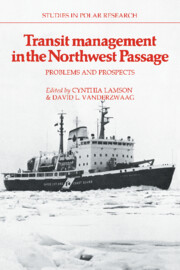Book contents
- Frontmatter
- Contents
- List of figures
- Acknowledgments
- PART I PERSPECTIVES ON THE PROBLEM
- 1 The Northwest Passage: a contrast of visions
- Post scriptum
- 2 The environment of the Northwest Passage
- 3 The development of Northern ocean industries
- 4 Arctic marine transport and ancillary technologies
- 5 Canadian arctic marine transportation: present status and future requirements
- 6 Northern decision making: a drifting net in a restless sea
- 7 Constitutional development in the Northwest Territories
- PART II PARADIGMS AND PROSPECTS
- APPENDIX: Statement on Canadian sovereignty
- CONTRIBUTORS
1 - The Northwest Passage: a contrast of visions
Published online by Cambridge University Press: 26 March 2010
- Frontmatter
- Contents
- List of figures
- Acknowledgments
- PART I PERSPECTIVES ON THE PROBLEM
- 1 The Northwest Passage: a contrast of visions
- Post scriptum
- 2 The environment of the Northwest Passage
- 3 The development of Northern ocean industries
- 4 Arctic marine transport and ancillary technologies
- 5 Canadian arctic marine transportation: present status and future requirements
- 6 Northern decision making: a drifting net in a restless sea
- 7 Constitutional development in the Northwest Territories
- PART II PARADIGMS AND PROSPECTS
- APPENDIX: Statement on Canadian sovereignty
- CONTRIBUTORS
Summary
The Northwest Passage – a marine short cut to the Orient for European trade. That was the historic vision of many. The history of the search for a Northwest Passage dates back to 1497 when John Cabot was sent by King Henry VII of England to find a northerly route to the Orient. Cabot's mission was taken up by later explorers, including Jacques Cartier, Sir Francis Drake, Sir Martin Frobisher, William Baffin, Captain James Cook, Sir John Ross and Sir William Parry, but none were successful and a number of voyages culminated in tragedy. In 1845 Sir John Franklin and the crews of the Erebus and Terror vanished while attempting to find a navigable route across the Arctic Ocean, and from 1847 to 1859 the vast Northern seas were explored from the east and west in search of the lost expedition. The first successful transit of the Passage by sea was achieved by the Norwegian explorer, Roald Amundsen, whose converted herring boat Gjoa completed the trip over a three-year span from 1903 to 1906. In the 1940s a Royal Canadian Mounted Police Sergeant, Henry A. Larsen, was the first person to transit the Passage in a single season in the schooner St Roch. The Labrador, a Canadian Coast Guard icebreaker, navigated the Passage in 1954 and as of September 1984, 41 surface vessels have completed transits of the Northwest Passage.
- Type
- Chapter
- Information
- Transit Management in the Northwest PassageProblems and Prospects, pp. 3 - 6Publisher: Cambridge University PressPrint publication year: 1988



